- News
- Reviews
- Bikes
- Components
- Bar tape & grips
- Bottom brackets
- Brake & gear cables
- Brake & STI levers
- Brake pads & spares
- Brakes
- Cassettes & freewheels
- Chains
- Chainsets & chainrings
- Derailleurs - front
- Derailleurs - rear
- Forks
- Gear levers & shifters
- Groupsets
- Handlebars & extensions
- Headsets
- Hubs
- Inner tubes
- Pedals
- Quick releases & skewers
- Saddles
- Seatposts
- Stems
- Wheels
- Tyres
- Tubeless valves
- Accessories
- Accessories - misc
- Computer mounts
- Bags
- Bar ends
- Bike bags & cases
- Bottle cages
- Bottles
- Cameras
- Car racks
- Child seats
- Computers
- Glasses
- GPS units
- Helmets
- Lights - front
- Lights - rear
- Lights - sets
- Locks
- Mirrors
- Mudguards
- Racks
- Pumps & CO2 inflators
- Puncture kits
- Reflectives
- Smart watches
- Stands and racks
- Trailers
- Clothing
- Health, fitness and nutrition
- Tools and workshop
- Miscellaneous
- Buyers Guides
- Features
- Forum
- Recommends
- Podcast
feature
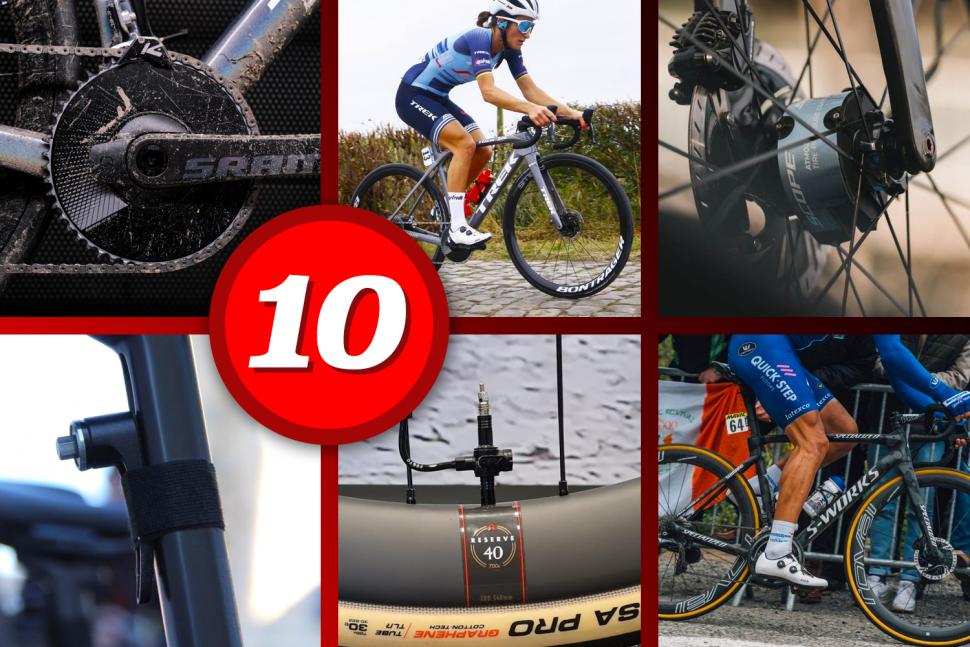 10 ways that Paris-Roubaix bikes have changed over the past decade April 2023
10 ways that Paris-Roubaix bikes have changed over the past decade April 202310 ways that Paris-Roubaix bikes have changed over the past decade — comparing 2012 to 2023 bike tech
The Paris-Roubaix cobbles put unique demands on bikes and both brands and teams work hard to supply the riders with the best equipment for the job. Here’s how the bikes have developed over the past decade.
Essentially, we're comparing the Paris-Roubaix Tech we saw in 2012 with the bikes that were ridden in the race last year. Some of the differences apply to bikes used throughout the race season, others are more particular to the Hell of the North.
Vibration-damping has come on a long way
Bike brands have been using Paris-Roubaix and the other cobbled races to showcase their endurance bikes – like Specialized’s Roubaix and Trek’s Domane – for years. It’s the ideal shop window for road bikes designed for comfort: “Look how well our bike handles the evil pavé of northern France; imagine what it can do for you.”
Typically, these bikes are built with an adjusted geometry, including a taller-than-normal head tube for a more upright ride position, and features to absorb vibration.
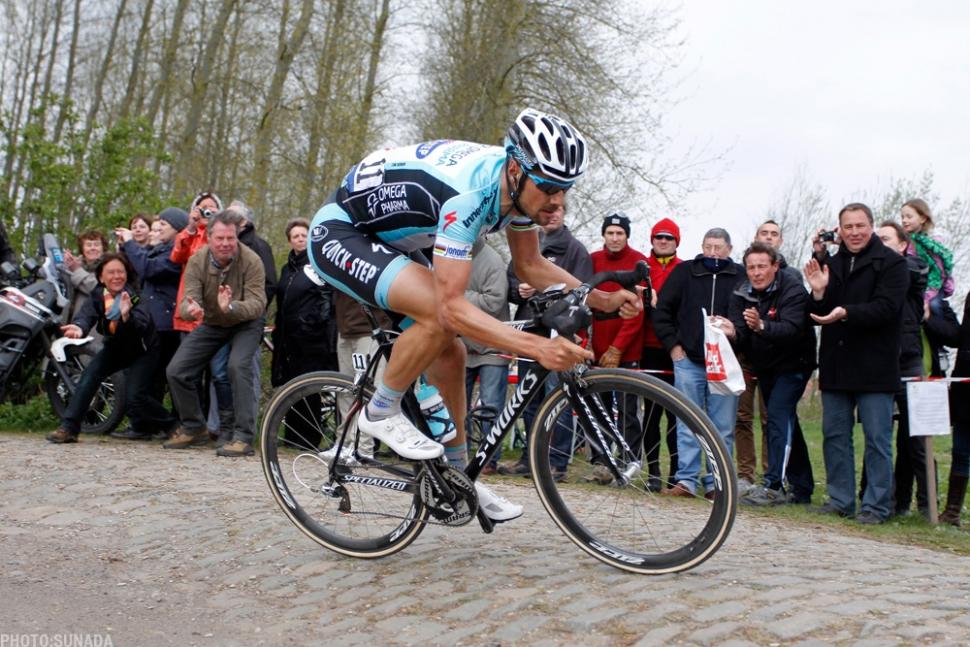 Back in 2012, Tom Boonen won Paris-Roubaix for a record-equalling fourth time on a yet-to-be-released Specialized S-Works Roubaix SL4.
Back in 2012, Tom Boonen won Paris-Roubaix for a record-equalling fourth time on a yet-to-be-released Specialized S-Works Roubaix SL4.
The bike featured Zertz inserts in the fork and seatstays designed to soak up irregularities – although the damping was actually down to the shaping and layup of the carbon and the Zertz just filled the space.
Last year, Bora-Hansgrohe riders used either the S-Works Roubaix or the S-Works Tarmac SL7 while Quick-Step Alpha Vinyl and TotalEnergies raced on the Roubaix.
 These days, there are no Zertz in sight. Instead, Specialized uses a Future Shock 2.0 suspension system in the head tube – which provides 20mm of damped movement – and an S-Works Pavé seatpost that’s designed for compliance.
These days, there are no Zertz in sight. Instead, Specialized uses a Future Shock 2.0 suspension system in the head tube – which provides 20mm of damped movement – and an S-Works Pavé seatpost that’s designed for compliance.
> Read our review of the Specialized Roubaix Comp Ultegra Di2
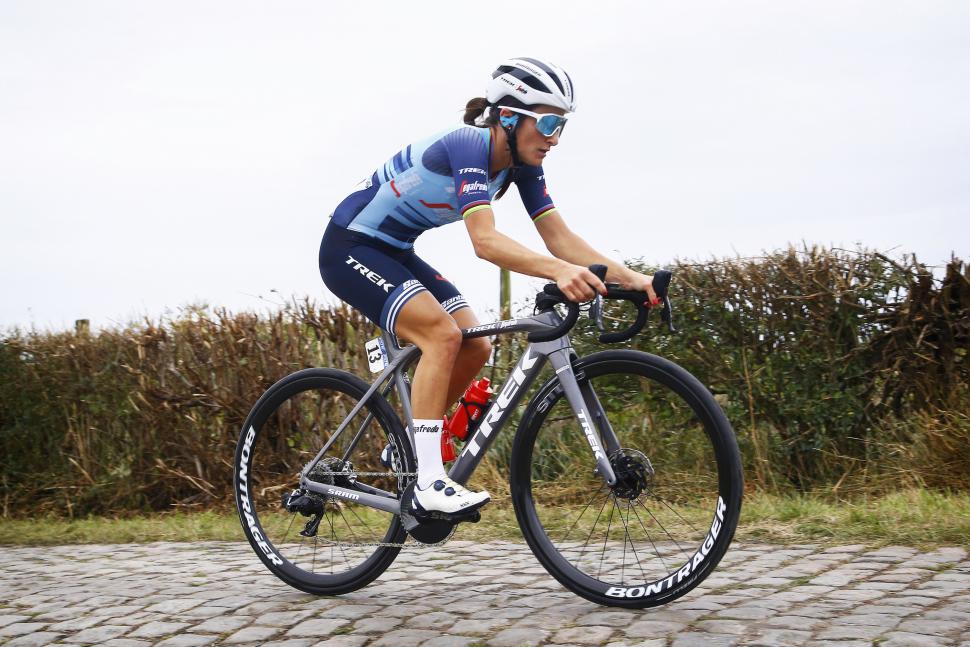 Pic: Cor_Vos SWPix.com
Pic: Cor_Vos SWPix.com
Paris–Roubaix Femmes has been run only twice and both Lizzie Deignan and Elisa Longo Borghini have won on Trek Domanes with the brand’s IsoSpeed technology
Isospeed made its first appearance in Paris-Roubaix in 2012 but it has developed since then.
> Trek Domane launch: Pave-busting road bike with… suspension + video
IsoSpeed was originally confined to the rear of the bike, allowing the seat tube – and therefore the saddle – to move relative to the rest of the bike. Trek made rear IsoSeed adjustable and added front IsoSpeed too, but that isn’t a feature of the 2023 race-focused Trek Domane RSL.
> Trek launches new, lighter Domane endurance road bike and ditches front IsoSpeed system
The bikes have got more aero
Despite all the talk of endurance bikes at Paris-Roubaix (above), the men’s race is more often won by a rider on a standard road frame. Dylan van Baarle rode a Pinarello Dogma F to victory last year, for example, and Sonny Colbrelli was on a Merida Reacto Team-E (below) the year before.
> The bikes that won Paris-Roubaix - Tubeless, disc and aero for Colbrelli and Deignan
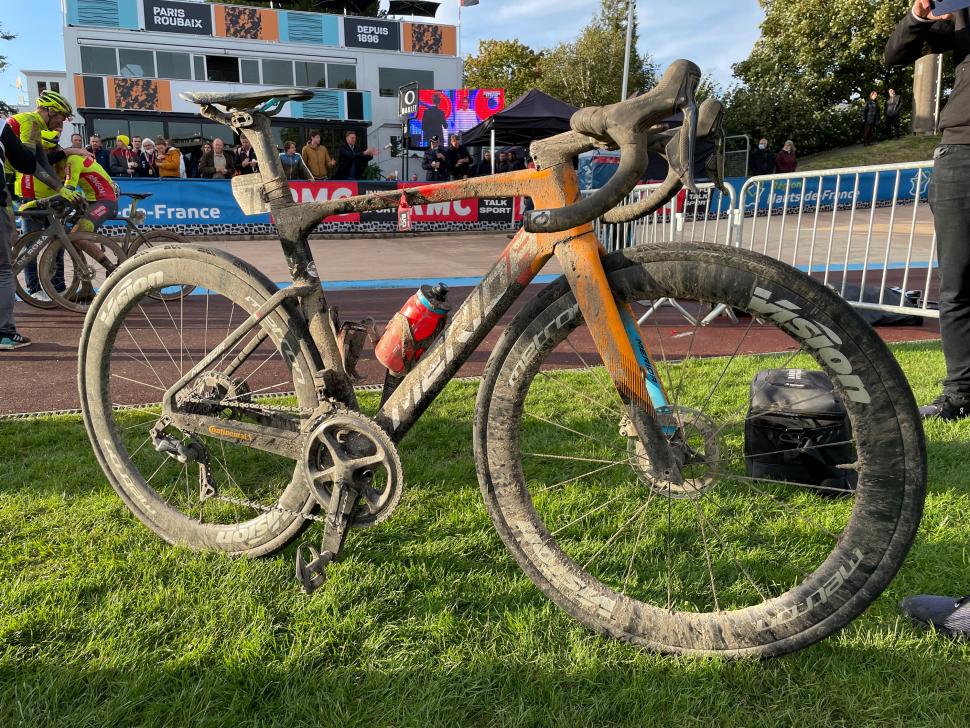
This year’s Paris-Roubaix is 256.6km (159.4 miles) long and the 29 cobbled sectors total 54.5km (33.9 miles). That leaves about 200km (125 miles) – 79% of the route – on mostly flat roads. Okay, the cobbles are usually decisive but riders aren’t in with a shout unless they’re gobbling up the road sections as efficiently as possible, which is why we see so many aero bikes skittering across the pavé.
> Philippe Gilbert’s Paris-Roubaix winning Specialized Roubaix
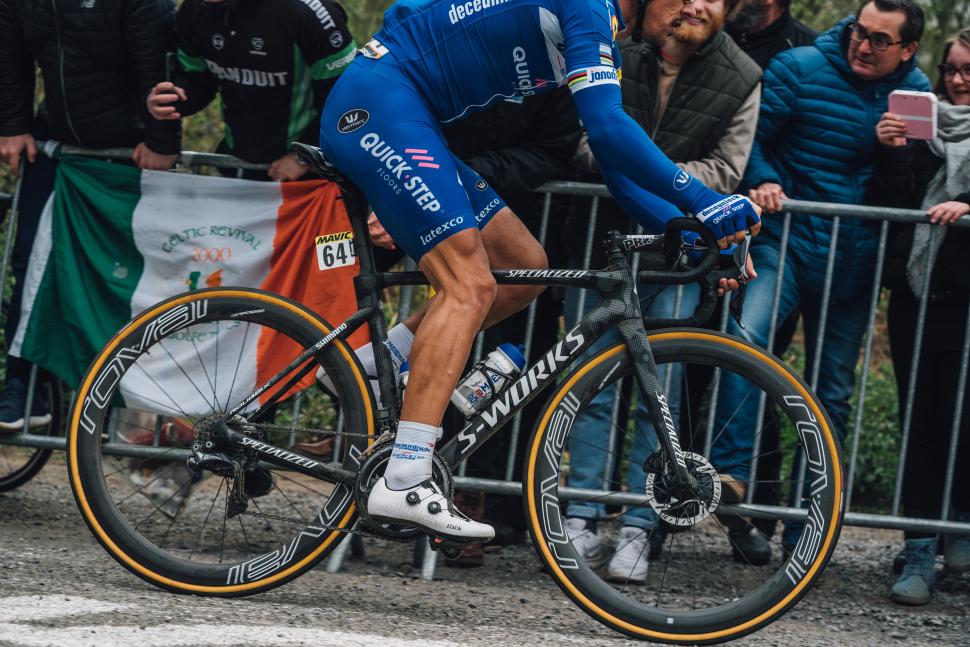 Even endurance bikes have become more aero, if the bike brands are to be believed. Specialized says that focusing on profiles for the head tube, fork blades, down tube, seat tube and seatpost allowed it to make the current Roubaix more aerodynamically efficient than the previous (non-aero-optimised) Tarmac SL6 road bike, for example.
Even endurance bikes have become more aero, if the bike brands are to be believed. Specialized says that focusing on profiles for the head tube, fork blades, down tube, seat tube and seatpost allowed it to make the current Roubaix more aerodynamically efficient than the previous (non-aero-optimised) Tarmac SL6 road bike, for example.
Tubeless tyres are taking over
Tubular tyres ruled the peloton back in 2012, not just for Paris-Roubaix but across the board. Now, though, tubeless tyres are gradually taking over. Like tubulars, tubeless tyres can be run at low pressures without the risk of pinch-flatting, and that’s a definite bonus over the cobbles.
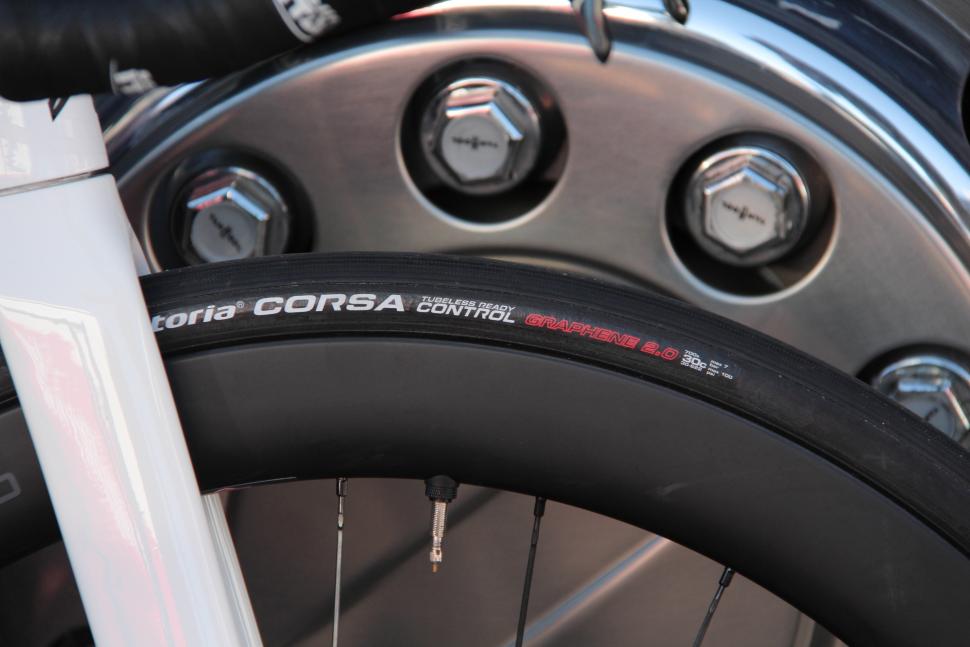 Mathieu van der Poel was on tubeless Vittoria Corsa Controls on his Shimano wheels last year, for example.
Mathieu van der Poel was on tubeless Vittoria Corsa Controls on his Shimano wheels last year, for example.
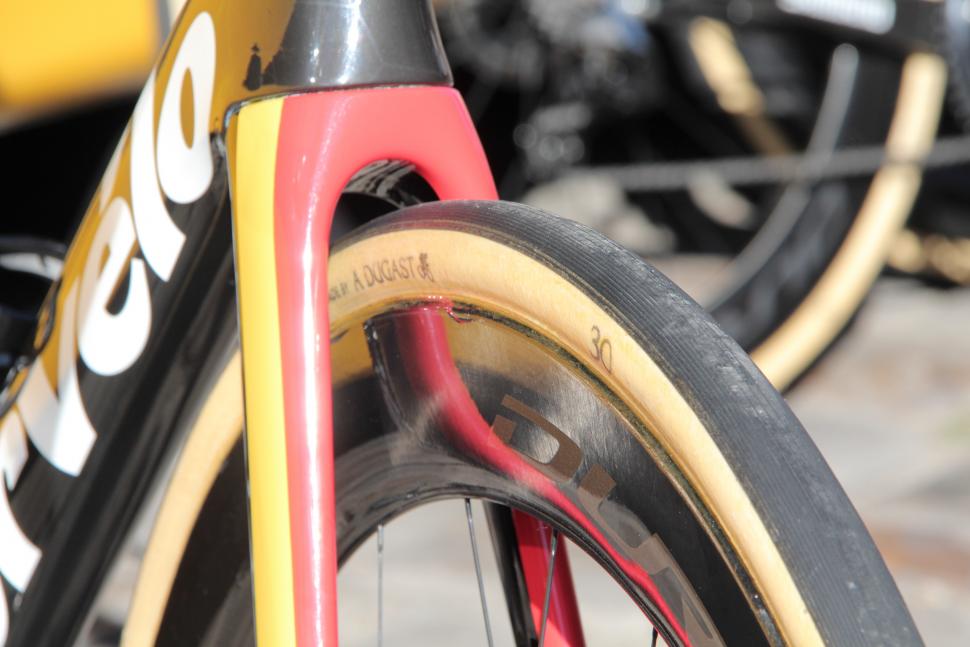 That said, tubulars still have their place. In 2022, Wout van Aert opted for Dugast tubs designed especially for the cobbles, his Jumbo-Visa team being one of many to switch out their normal supplier for this one day of the year.
That said, tubulars still have their place. In 2022, Wout van Aert opted for Dugast tubs designed especially for the cobbles, his Jumbo-Visa team being one of many to switch out their normal supplier for this one day of the year.
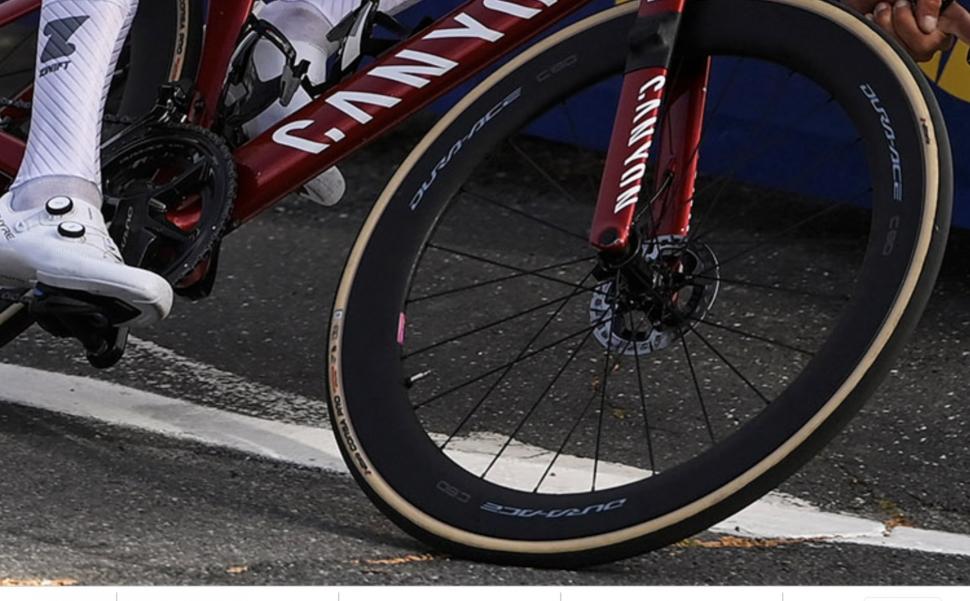 We’ve seen loads of pros, including both Van der Poel and Van Aert, riding Vittoria’s not-yet-released Corsa Pro tyres over the past few weeks so it’ll be interesting to see whether they get an airing over the pavé.
We’ve seen loads of pros, including both Van der Poel and Van Aert, riding Vittoria’s not-yet-released Corsa Pro tyres over the past few weeks so it’ll be interesting to see whether they get an airing over the pavé.
There were 30mm tyres in the 2012 Paris-Roubaix and that’ll be the same this year. It’ll be interesting to see if anyone goes much wider than that.
On-the-fly tyre pressure adjustment will appear for the first time in 2023
One thing we certainly didn’t see in the 2012 Paris-Roubaix was on-the-fly tyre adjustment – because the technology didn’t exist – but it looks set to make an appearance this year after Jumbo-Visma’s Edoardo Affini used it in Dwars door Vlaanderen last week.
> On-the-fly tyre pressure adjustment appears on Dwars door Vlaanderen cobbles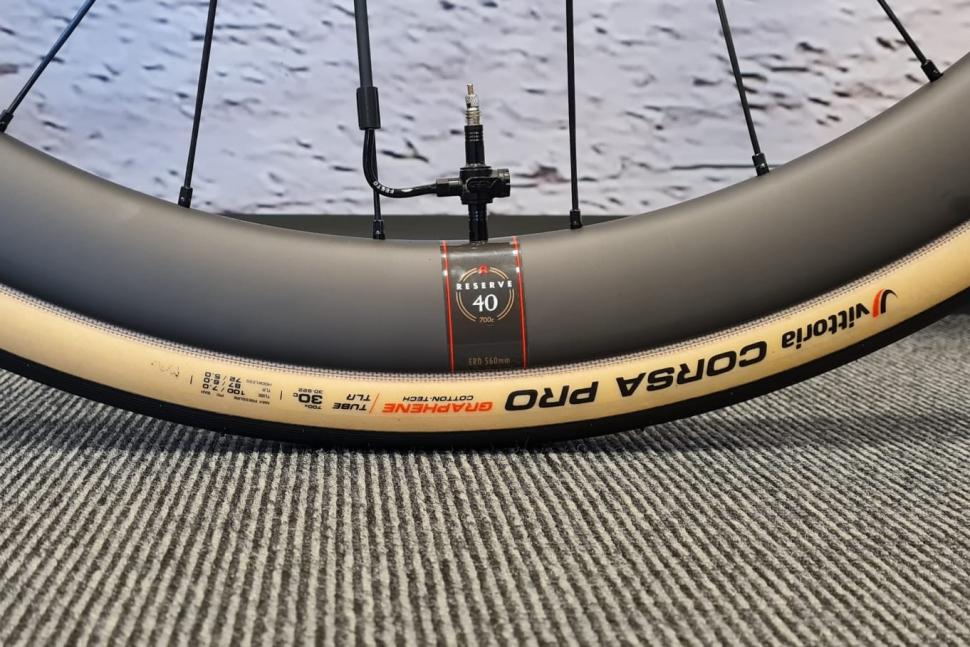
Essentially, this tech allows the rider to adjust tyre pressure while riding by pushing a button on the handlebar.
If you’ve ever ridden cobbles you’ll know why this could be a huge benefit. They can knock you around all over the place, especially cobbles like you find on the Arenberg Trench. On top of that, Gravaa, the company behind the KAPS system used by Edoardo Affini, argues that “there is a significant increase of rolling resistance on cobblestones [ridden with] higher tyre pressures”.
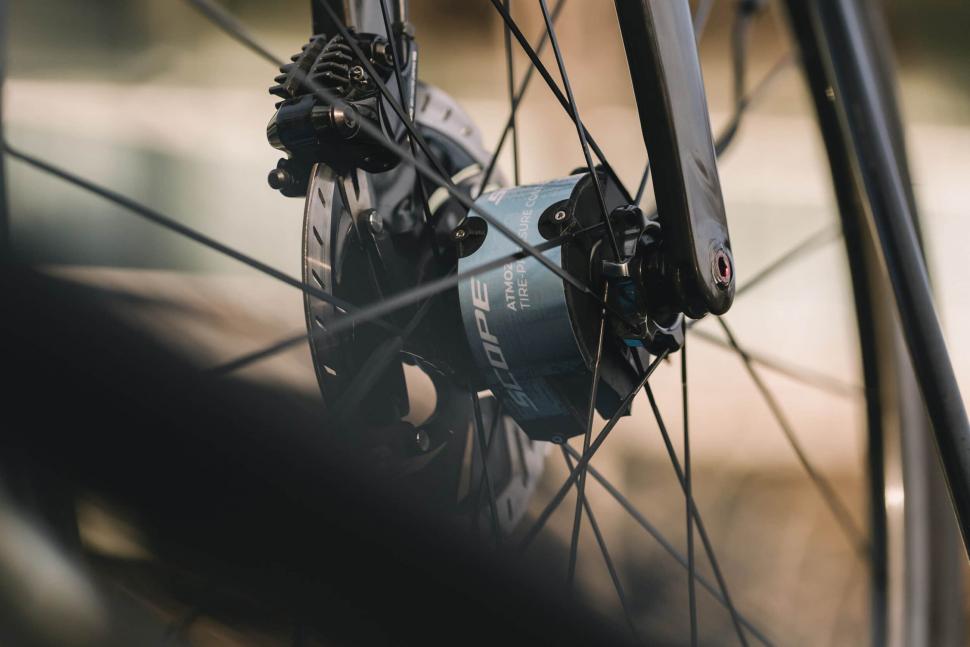 We reported last year that Team DSM was experimenting with Scope Atmoz hubs that perform a similar function, although the technology wasn’t used on race day.
We reported last year that Team DSM was experimenting with Scope Atmoz hubs that perform a similar function, although the technology wasn’t used on race day.
It looks like Team DSM will use the Scope Atmoz system this time around, though, so it’ll be hugely interesting to see how things go.
Mechanical shifting: RIP
Although electronic groupsets had already been introduced, some riders were still using mechanical shifting in the 2012 edition of Paris-Roubaix.
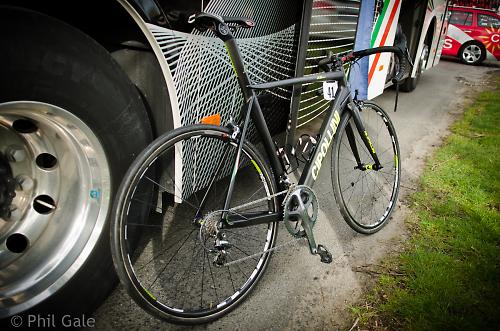
We reported, “Despite having proved its durability over the last few seasons in cyclocross races and in the pro peloton, a number of riders ditched their Di2 shifters in favour of mechanical Shimano Dura-Ace for Roubaix.”
Multi-time classics winner Fabian Cancellara famously stuck with mechanical shifting way longer than most other riders and Peter Sagan won Paris-Roubaix in 2018 with mechanical Dura-Ace and rim brakes.
> Peter Sagan’s Paris-Roubaix winning Specialized S-Works Roubaix bike
Some riders opted for mechanical because they preferred the positive feel of moving a lever to the press of a button on an electronic system.
On the flip side, one of the benefits of an electronic system is the ability to fit additional buttons to the inside of the drop or on the tops, providing extra shifting positions – hence this setup (above) from 2022.
Chances of seeing mechanical shifting used in Paris-Roubaix 2023? Zilch! For a start, the latest version of the Shimano Dura-Ace groupset used by most pro teams is Di2 only and many top-end bikes aren’t designed to accommodate cables anyway.
1x drivetrains are now an option
1x (a single chainring setup) wasn’t a thing in road racing back in 2012 but, although not common in the pro peloton, we see it from time to time on SRAM-supported teams.
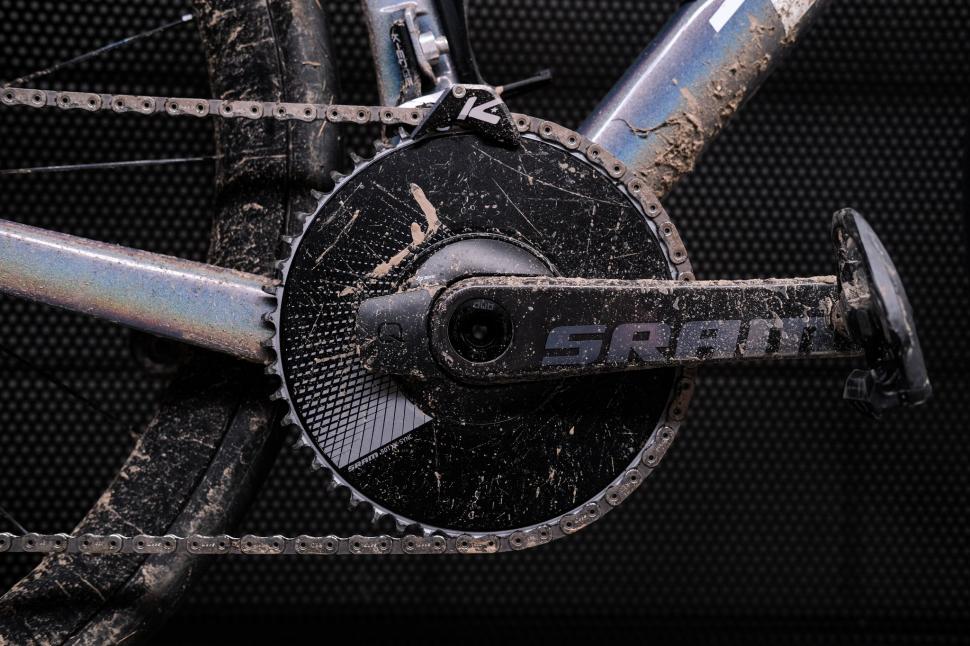 Pic: JoJo Harper/Trek Bikes
Pic: JoJo Harper/Trek Bikes
Wout van Aert recently went with 1x for Milan-San Remo, for example, while both Lizzie Deignan and Elisa Longo Borghini have won Paris-Roubaix Femmes with single chainring setups.
1x is certainly an option for a flat route like Paris-Roubaix where an inner ring isn’t required.
Thru-axle levers strapped to the seat post
Last year we noted that thru-axle levers attached to the seatpost by Velcro straps were a common sight, allowing riders to get the wheel off in the event of a puncture or other mechanical issue.
This is a modern development. Thru axles weren’t a feature of road race bikes back in 2012.
Disc brakes have wiped out rim brakes
Back in our 2012 review of Paris-Roubaix tech, we said, “Liquigas Cannondale, possibly in a sign of things to come, turned up with a disc brake-equipped Cannondale ’cross bike [below]. They didn't use it, but it certainly turned some heads and probably gave the commissaires a fit of the vapours.”
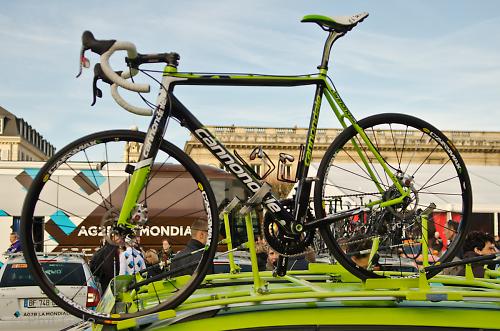
Wow! How times change!
In the 2016 edition of the race, Movistar rider Fran Ventoso suffered a deep cut to his leg and said that a disc brake rotor was to blame. He also said that a deep wound sustained by Etixx-Quick Step rider Nikolas Maes was produced by another disc rotor, although road.cc just happened to take photographs of that incident so we could clearly demonstrate that disc brakes weren’t involved.
> Have disc brakes really led to injuries in peloton?
Anyway, the upshot was that disc brake use was suspended in the peloton for a while before being authorised for road racing on a permanent basis in 2018.
Rim brakes are rarely seen on pros’ bikes now. Tadej Pogacar used a rim brake Colnago V3Rs (which has since been superseded by the V4Rs) to help secure victory in Tirreno-Adriatico last year but that was to save weight for the climbs and Paris-Roubaix has few of those.
> Check out Tadej Pogacar’s rim brake Colnago V3Rs
No more supplementary brake levers
Supplementary brake levers used to be a common sight at Paris-Roubaix.
This is the Cofidis bike from 2012, for example. The idea was to give the rider more control when riding with their hands on the tops.
With the advent of disc brakes, though, additional levers have disappeared.
External cables? What are they?
This isn’t something particular to Paris-Roubaix but one of the most noticeable differences between modern bikes and those of a decade ago is the lack of external cables.
Check out this Wilier being ridden by Lampre in 2012, for example. All of the cables were external, the gear cables running along the outside of the down tube and the rear brake cable along the underside of the top tube.
These days, SRAM Red eTap is wireless and Shimano Dura-Ace Di2 is semi-wireless. Campagnolo Super Record is just about to become wireless too.
You might catch a glimpse of a brake hose on the underside of a stem or towards the bottom of a fork leg but everything else is well hidden.
Mat has been in cycling media since 1996, on titles including BikeRadar, Total Bike, Total Mountain Bike, What Mountain Bike and Mountain Biking UK, and he has been editor of 220 Triathlon and Cycling Plus. Mat has been road.cc technical editor for over a decade, testing bikes, fettling the latest kit, and trying out the most up-to-the-minute clothing. He has won his category in Ironman UK 70.3 and finished on the podium in both marathons he has run. Mat is a Cambridge graduate who did a post-grad in magazine journalism, and he is a winner of the Cycling Media Award for Specialist Online Writer. Now over 50, he's riding road and gravel bikes most days for fun and fitness rather than training for competitions.
Latest Comments
- BikingBud 37 min 29 sec ago
How can anybody reject the beauty of that? It's a wonderful mix of modern tech yet absolutely functional.
- mdavidford 52 min 56 sec ago
I know he's been famously arrogant and litigious, but surely even he doesn't have the gall to attempt to patent that?
- mdavidford 1 hour 25 min ago
Now I don't do any of this InstaTok business, so I could well be wrong, but it looks to me like he's only outed himself as a follower of someone...
- amawby 1 hour 45 min ago
Not unless theVED is made eye wateringly expensive....
- mdavidford 1 hour 56 min ago
My mum always told me I'd inherited her 'hobbit feet', though as far as I'm aware we don't have any family in New Zealand.
- andystow 2 hours 13 min ago
Hyponatremia is a real risk even for an amateur cyclist or runner in hot weather. I've bonked from it before, and I was drinking Gatorade the whole...
- wtjs 2 hours 55 min ago
in the UK we have policing which to a greater or lesser extent relies on assistance from members of the public......
- Cadcam 3 hours 59 min ago
Just wanted to share a quick thank you to everyone who helped out in this thread....
- SecretSam 4 hours 14 min ago
So...don't cycle on it. Lots of other routes around that area. Source: I used to work there.
- Steve K 4 hours 33 min ago
My photochromic specs have just turned up in the post today

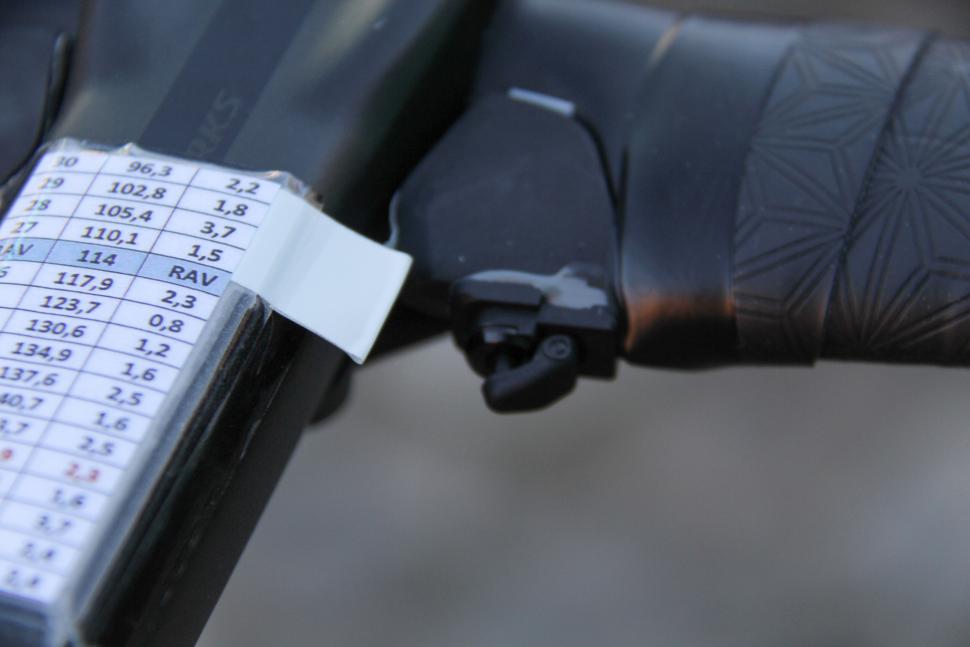
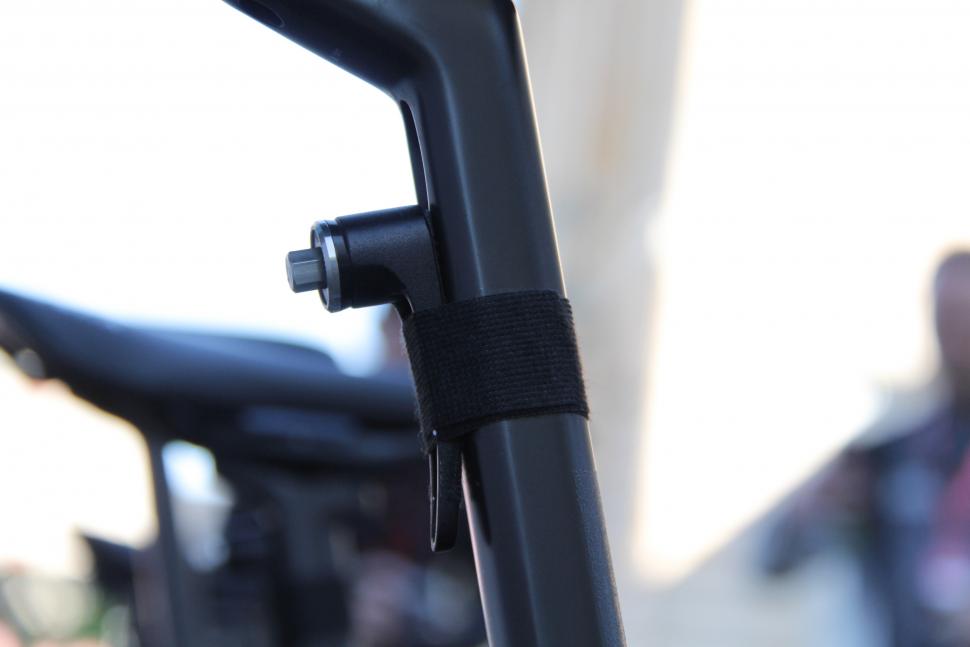


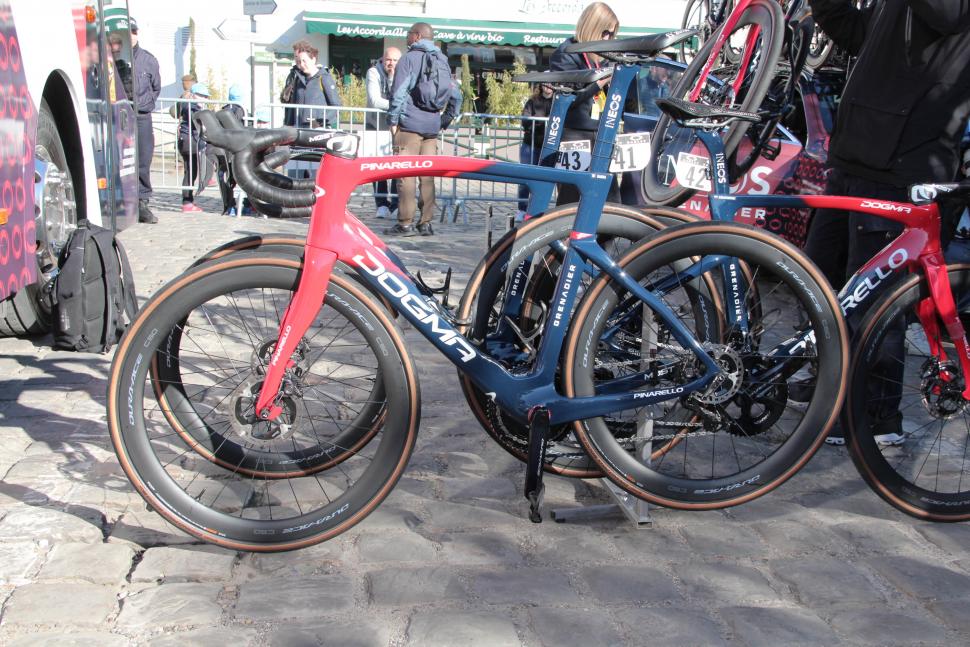
Add new comment
3 comments
The Roubaix shown in the photo ridden by Philippe Gilbert (64) is an interesting development. It's a "Roubaix Team", developed as a response to Specialized wanting their supplied teams to ride a bike called a Roubaix at the cobbled classics, but the riders possibly thinking it's not really fast enough, less than 25% of P-R is pavé, the rest is pan-flat tarmac. There's "only" around 50km of cobbled secteurs, and so the Tarmac or Venge would have been preferable given the average speeds now. The result was the Roubaix Team, available as frameset only, in that single urban camo colourway. Just 3 sizes were available. It's basically a Tarmac geometry front end (although still including the oil damped version of the Future Shock 2.0 headset), with the Roubaix rear end with the Pavė seatpost clamped low down in the tube for compliance. The sizes are odd, only available in 53, 57, 59 instead of the usual range of even numbers from Specialized, to reflect that it's longer & lower than the equivalent standard Roubaix.
First time out at Paris Roubaix, it was ridden to 1st & 3rd by Gilbert & Lampaert, with another 3 riders in the top 10.
Apologies for long rambling anoraky post, it's just that I've got one and it's a great bike, both fast and comfortable.
Didn't Hope develop some additional levers for their road bike braking systems?
And I hope Matt wrote this mostly yesterday and is having a day off like most of us, but thanks for the additional content.
I think shimano do some as part of the grx group don't they?